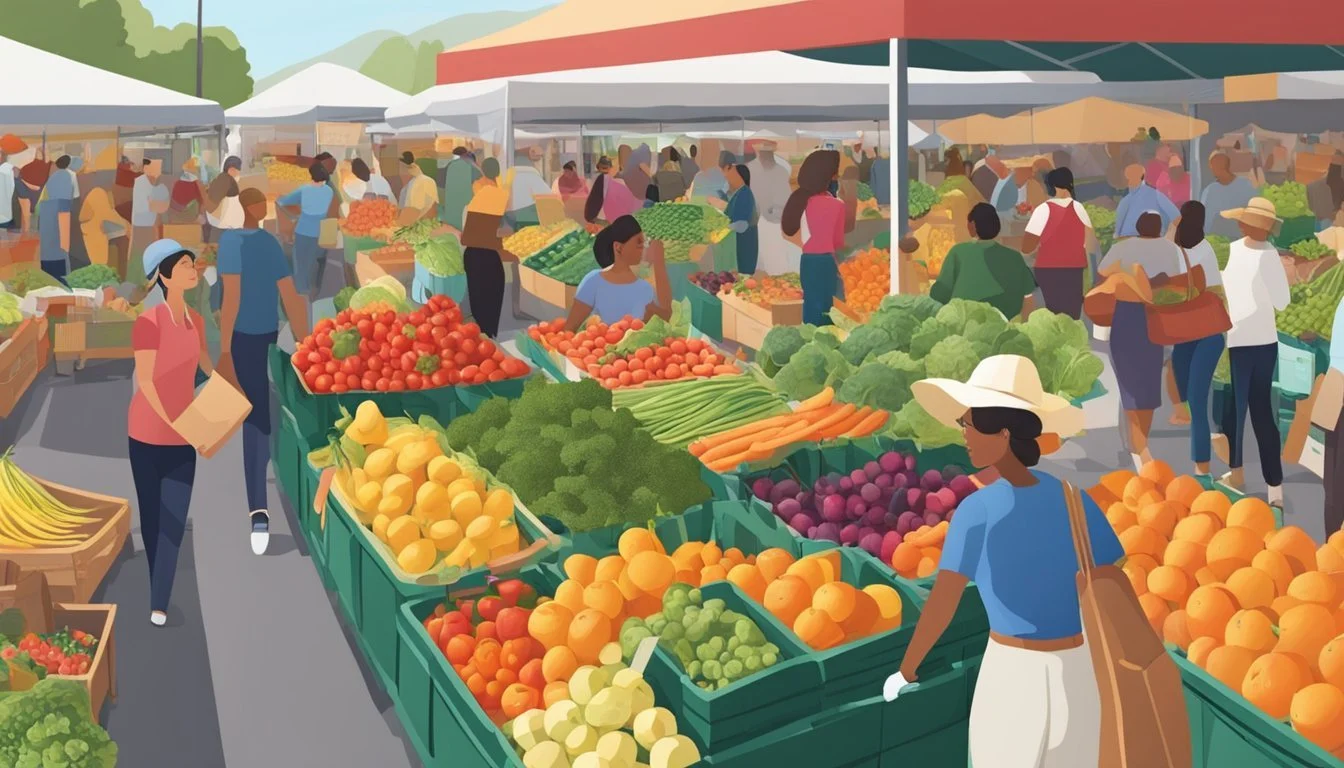Farmers' Market Fitness
How to Combine Fresh Produce Shopping with an Effective Exercise Routine
Visiting the local farmers' market is an activity that marries the benefits of sourcing seasonal, fresh produce with the opportunity to integrate physical activity into daily errands. Unlike the static environment of a typical grocery store, a farmers' market provides a dynamic setting for engaging different muscle groups as one walks, carries, and navigates through the stalls.
Incorporating fitness into a farmers' market trip can be a practical and effective way to exercise. Patrons can transform the task of shopping into a workout through deliberate actions such as carrying heavier bags to build strength or opting for multiple laps around the market to increase their step count. The combination of these physical exertions, along with the health benefits of the fresh, nutrient-rich foods available, mutually reinforces one’s health and fitness goals.
Preparing a shopping list in advance ensures that time at the market is spent efficiently, and temptation for less healthy options is minimized. Engaging with farmers and vendors not only offers insight into the best seasonal produce but can also contribute to a heightened sense of community engagement, bolstering mental as well as physical fitness. Shopping at a farmers' market, therefore, is not just a chore; it is a holistic approach to well-being that encourages people to be active participants in their health.
Benefits of Farmers' Market Workouts
Farmers' markets provide an excellent opportunity to incorporate physical activity into routine errands. By turning a shopping trip into a fitness routine, individuals can enjoy a dual benefit of completing chores while improving health.
Combining Exercise with Grocery Shopping
Shopping at a local farmers market naturally incorporates exercise into an individual's day. They carry their purchases, walk from stall to stall, and sometimes cover considerable distances within the market area. This physical activity can add to a person's daily step count, helping to meet cardiovascular exercise goals. Shopping can become a form of functional fitness, where lifting and carrying groceries act as a form of strength training.
Fresh Air and Community Engagement
Farmers' markets are typically outdoor venues, providing shoppers with plenty of fresh air and vitamin D from sunlight, contributing to overall wellbeing. Interacting with community members and local farmers can boost mental health through social engagement. The environment at a local farmers market is vibrant, fostering a sense of community and belonging which is essential for emotional health.
Planning Your Farmers' Market Fitness Routine
Integrating fitness into a farmers' market visit requires a well-thought-out plan focusing on clear fitness objectives, a harmonized shopping-workout schedule, and the right items to enhance the workout effectively.
Setting Fitness Goals
One should establish realistic fitness goals based on the distance of the market and the time they can commit. Goals might include a certain number of steps, total distance to walk, or number of squats and lunges. For example:
Steps: Aim for 5,000 to 10,000 steps, using a pedometer to track.
Distance: Set a goal to walk the entire perimeter of the market twice.
Strength Exercises: Plan for intermittent sets of squats after each purchase.
Creating a Shopping and Workout Schedule
Balancing the shopping list with workout activities requires strategic timing. Consider the following plan:
Early Arrival: Anticipate a workout before the market gets crowded.
Segmented Shopping: Shop for produce, then perform a set of exercises. Repeat.
Closing Time: Walk briskly between vendors as they offer last-minute deals.
A sample schedule:
Time Activity 8:00 am 10-minute brisk walk upon arrival 8:15 am Stretching and warm-up exercises 8:30 am Purchase items; follow with squats 9:00 am Mid-visit walk around market perimeter 9:30 am Final purchases; end with lunges 10:00 am Cool down walk and stretching
What to Bring to Maximize Your Workout
Shoppers should carry light items to avoid strain yet enough to serve as weights. Essentials to bring include:
Comfortable Backpack: Distribute purchases evenly for balance.
Cash: Quick transactions save time for more exercise between stands.
Meal Plan: Align purchases with the meal plan to ensure a focused shopping list that will reduce idle time and maintain the workout momentum.
It's important to stay hydrated, so bringing a water bottle is also recommended.
Workout Tips at the Farmers' Market
Visiting a farmers' market offers a unique opportunity to combine local food shopping with a functional fitness routine. Shoppers can turn their market stroll into a calorie-burning workout, enhancing their strength and stamina while supporting local agriculture.
Navigating the Market for Maximum Fitness Gain
To maximize fitness gains, shoppers should plan a walking route that covers the entirety of the farmers' market. Mapping out a path that includes several laps can increase the distance walked. They are encouraged to quicken their pace akin to a brisk walk to elevate their heart rate, thereby transforming a leisurely shopping trip into a cardiovascular exercise.
Begin at one end of the market and finish at the opposite end.
Complete at least three laps to increase overall distance covered.
Additionally, selecting products from various vendors spaced apart ensures a broader walking scope and encourages more steps taken during the visit.
Incorporating Strength Training with Shopping Bags
Shopping bags can double as weights for an impromptu strength workout while browsing the market stands. As shoppers fill their bags with local produce, the gradual increase in weight can be used for arm curls or shoulder lifts. This method conditions muscles in a similar manner to traditional weight training, enhancing muscle tone and strength.
Bag Lifts: Hold bag handles firmly and perform arm curls while walking between stands.
Start with bags as empty as possible and gradually add produce to increase weight.
Maintain a straight posture to engage core muscles.
Shoulder Presses: Carefully lift the bags to shoulder height and then above the head.
Ensure solid footing and balanced weight distribution to prevent injury.
In addition to building strength, the act of carrying heavier shopping bags also stimulates muscle growth and encourages protein synthesis within the body, essential for muscle repair and development. Integrating these simple movements into the market trip can convert the shopping experience into a functional workout routine.
Selecting Produce for Nutrition and Fitness
When visiting a farmers' market, consumers have the unique opportunity to select fresh produce that enhances both nutrition and fitness. By choosing items high in nutrients and suited for energy and recovery, individuals can support their active lifestyles effectively.
Identifying Nutrient-rich Foods
Nuts and Seeds: A source of protein and healthy fats. Include varieties such as almonds and flax seeds to support muscle repair and cognitive function.
Leafy Greens: Spinach and kale are rich in iron and calcium, essential for strong bones and oxygen transport in the blood.
Eggs: Often available at farmers' markets, they are a complete protein and provide vitamin B12, crucial for energy metabolism.
Nutrient Benefit Produce Examples Vitamin C Antioxidant, immune support Bell peppers, citrus fruits, strawberries Vitamin A Eye health, immune function Carrots, sweet potatoes, pumpkin Potassium Muscle function, hydration Bananas, potatoes, avocados Fiber Digestive health, satiety Apples, pears, leafy greens Omega-3 Fatty Acids Inflammation reduction Walnuts, flax seeds Magnesium Muscle recovery, nerve function Spinach, almonds, pumpkin seeds
Fruits and Vegetables for Energy and Recovery
Carbohydrates for Energy: Choose fruits high in natural sugars for a quick energy boost pre-workout. Apples, bananas, and berries provide easily digestible sugars and a range of vitamins.
Antioxidant-rich Produce: Berries, plums, and leafy greens contain antioxidants that combat oxidative stress and may enhance recovery post-exercise.
Vegetables for Replenishment: Post-workout, select vegetables like sweet potatoes and beetroot, which offer complex carbohydrates for replenishing glycogen stores, and are also a good source of fiber and micronutrients.
Seasonal Fitness and Dietary Considerations
Integrating seasonal fitness activities and dietary habits can maximize health benefits. This approach takes advantage of varying weather conditions and the availability of fresh, in-season produce.
Adapting to Weather Conditions
One can tailor their outdoor fitness routine to the current season. For instance, in summer, individuals may schedule their farmers' market visits early in the morning to avoid peak heat. By doing so, they not only enjoy shopping in cooler temperatures but also turn their shopping trip into a refreshing workout, walking or cycling to the market when feasible.
Stay hydrated with water.
Wear light-colored, breathable clothing.
Apply sunscreen to protect against UV rays.
Incorporating Seasonal Produce into Your Diet
During different seasons, a variety of produce becomes available, which can be nutritious and invigorating for the body. In summer, farmers' markets are abundant with berries and asparagus, offering high levels of antioxidants and essential vitamins. Shoppers can add these items to their diets by picking fresh seasonal produce during their market workouts.
Examples of Summer Seasonal Produce:
Berries: Rich in antioxidants.
Asparagus: High in fiber and vitamins A, C, and E.
By eating produce that is in season, individuals not only gain nutritional advantages but also contribute to the local economy and environment by reducing food miles and packaging.
Interacting with Farmers and Vendors
Engaging with farmers and vendors at the local market not only assists in making informed choices for fitness-focused shopping but also fosters a sense of community and supports the local harvest.
Asking Questions for Better Choices
When shopping at farmers' markets, customers should take the opportunity to ask vendors specific questions about the products they offer. Inquiry into farming practices, such as "Do you use sustainable methods?" or regarding the freshness of produce, "When was this harvested?" can guide shoppers to make healthier choices. Asking questions empowers buyers to select items that are at the peak of their nutritional content, an essential element for those integrating their market trips with a fitness routine.
Benefits of asking questions include:
Enhanced knowledge of local produce
Making informed decisions aligned with fitness and health goals
Understanding the seasonality and peak freshness of items
Building Relationships for Future Visits
Developing rapport with farmers and vendors can yield numerous benefits for future shopping experiences. Regular interaction with local farmers allows them to understand a customer's preferences and can lead to personalized product suggestions. Moreover, establishing a familiar presence may result in beneficial arrangements such as pre-orders or reserving goods known to align with the buyer's fitness goals.
Strategies for building relationships:
Consistently visit the same vendors to become a recognizable patron
Express gratitude for the vendor's hard work and quality produce
Inquire about specific items that could be pre-ordered for future pick-ups
By consistently engaging with vendors, shoppers reinforce the community aspect of the market and contribute to the vitality of the local farmers' business. Such interactions ensure a rich and rewarding experience with each visit to the farmers' market.
Money-Saving Strategies while Shopping
Economizing at farmers' markets is straightforward if one knows which strategies to apply. Shoppers can significantly slash their expenses by tapping into discounts and making smart bulk purchases for future use.
Making Use of Discounts and Deals
Vendors at farmers' markets may offer discounts on their produce towards the end of the market day, to reduce food waste. Shoppers should not hesitate to politely inquire about potential end-of-day deals, or if there are any discounts available for imperfect produce that is still perfectly usable. Some sellers also provide loyalty discounts for repeat customers, so forming a good relationship with vendors can lead to savings over time.
Buying in Bulk and Canning
Purchasing in bulk often leads to lower prices, as many market vendors give deals for larger quantities. For example:
Kale: Buy 3 bunches for $5 instead of $2 each.
Tamales: Purchase 4 packages, get 2 additional for free.
After buying in bulk, shoppers can reduce food waste and extend their savings by canning their produce. This not only preserves the food for off-season use but also ensures that shoppers can enjoy the healthy, local produce year-round. It's an excellent strategy to save money and avoid future grocery purchases when prices for those items may be higher.
Understanding the Impact of Local Produce
Local produce has a significant influence on sustainability and the local economy. It also plays a crucial role in reducing the carbon footprint associated with food consumption.
Sustainable Agriculture and Local Economy
Local farmers markets serve as critical hubs for sustainable agriculture by providing a platform for farmers to sell directly to consumers. This model benefits the local economy as funds are reinvested within the community, supporting small-scale producers and creating jobs. Here are ways in which local markets impact the economy and sustainable agricultural practices:
Job Creation: Small-scale farming necessitates a larger workforce, contributing to local employment.
Direct Sales: Farmers receive a greater share of the profits without intermediary expenses.
Organic Options: Many local farmers employ organic farming practices, which avoids the use of harmful pesticides and fertilizers.
Diverse Crops: Sustainable agriculture promotes the growth of a range of crop varieties, enhancing biodiversity.
Minimizing Carbon Footprint through Local Shopping
Shopping locally at farmers markets contributes to the reduction of carbon emissions in several ways:
Reduced Transportation: Local produce travels a shorter distance to market, drastically cutting down on fuel consumption and emissions.
Less Packaging: Produce is often less packaged than supermarket equivalents, minimizing waste.
Seasonal Consumption: Consumers are encouraged to eat seasonally, which aligns with nature's growing cycles and reduces energy used in food production and storage.
By choosing to purchase from local vendors at farmers markets, individuals help foster a more environmentally sustainable food system.
Post-Market Fitness and Meal Preparation
After returning from the farmers' market, individuals often have an abundance of fresh produce. The focus now shifts to integrating these items efficiently into meals while engaging in light exercises to aid post-shopping recovery.
Incorporating Fresh Produce into Regular Meals
Shopping list synchronization: A shopper should align their meal plan with the seasonal produce available at the farmers' market. This approach ensures the meal plan remains flexible and dynamic, promoting the use of fresh ingredients throughout the week. For instance, if heirloom tomatoes and fresh basil are in abundance, they can consider a recipe for a savory tomato basil salad.
Recipe rotation: It's crucial to have a set of recipes that are adaptable to the varying produce found at the market. They should not shy away from trying new food varieties, which can refresh their regular meal rotation and offer culinary excitement.
Sample Recipe (Tomato Basil Salad):
Ingredients: 5 heirloom tomatoes (wedges), ¼ cup fresh basil (chopped), 1 minced garlic clove, 1 tablespoon olive oil, 3 tablespoons balsamic vinegar
Directions: Toss ingredients and serve atop fresh greens
Recovery Exercises After Shopping
Stretching: Upon returning with groceries, one should not underestimate the importance of stretching to prevent muscle soreness. Simple stretches such as shoulder rolls, neck tilts, and arm circles can be beneficial.
Core and stability exercises: They can convert groceries into workout tools before they are stored away. For example, using a heavier produce item like a watermelon for weighted squats or a bag of apples for arm curls can add an element of strength training to the post-shopping routine, engaging the core and promoting balance.
Exercise Ideas:
Weighted Squats: Holding a sturdy produce item, stand with feet shoulder-width apart, and perform squats.
Arm Curls: Use a bag of apples with each arm alternatively, focusing on the biceps.
By integrating meal planning with fitness, one can maximize the benefits of their farmers' market visit, all the while promoting a sustainable, waste-reducing lifestyle, and enhancing their personal well-being.








